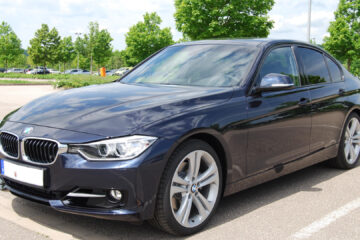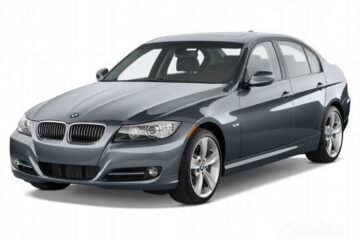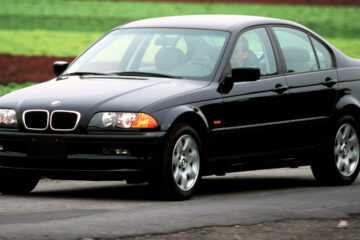BMW 3 series E30 began production in 1982, and ended production in 1994. Therefore, it is almost impossible to find a copy in normal condition on the modern secondary car market. The Western market is already characterized by a gradual increase in prices for this model, as it is moving into the category of classic retro cars.
In its years, the BMW 3 series E30 was quite an advanced car in technical terms, which was complemented by a dynamic chassis. A distinctive feature was also the longitudinal installation of an inline six-cylinder powertrain. There was no competition until Mercedes launched the 190E with a 2.6-liter engine in 1985.
Appearance
For its time, the body of BMW E30 was characterized by quite a good design, but it is not worth comparing it with modern cars, although something worthwhile in it has remained to this day. The hood is characterized by small reliefs, which are located not far from each other. The first thing that catches the eye, and for which the car really started to be loved, is the four headlights of the head optics, not distinguished by their size. The front of the car is made more aggressive by the fact that the headlights are slightly recessed. The radiator grille does not stand out from the company’s overall concept and is done in the corporate style. The bumper is quite simple. It differs only in the presence of a black molding, on which the turn signals are located.
In the photo of the BMW E30, the simplicity and modesty of the side of the car is noticeable. Only the top line and the wheel arches, which are slightly swollen, catch the eye. A small molding is also present in the middle of the car. The side windows do not stand out from the general concept of the Bavarians. They are equipped with a large trim made of chrome.
Many fans of the model slightly disliked the rear of the car because of the insufficient height of the trunk. The trunk lid itself has no reliefs, but stands out with flat shapes. Just below the trunk lid are rectangular-shaped lights that have a halogen device. The BMW E30 dodger is somewhat old and special design does not stand out. Therefore, many owners of such cars prefer to install body extensions to give the car a more modern appearance. But at the same time, it is able to withstand the full power of the car during an accident and light impacts do not leave marks on it.
The dimensions of the BMW E30 sedan are as follows: the length is 4321 millimeters, with a width of 1641 millimeters. The wheelbase is only 2570 millimeters. The height of the car body is 1379 millimeters. This made it possible to get a ground clearance of 125 millimeters.
The dimensions of the BMW E30 coupe differ only in ground clearance, which amounted to 140 millimeters. The weight of the coupe was from 1000 to 1176 kilograms depending on the configuration. The weight of the car in a sedan body: from 1030 to 1195 kilograms. The cabriolet version does not differ in size. The difference is only in the weight, which is from 1220 to 1280 kilograms.
Interior
The interior of the BMW e30 looks quite qualitative for its time, but if you look at it taking into account modern measures, it is just terrible. When the model was assembled, little money was given to comfort, so you shouldn’t be surprised. The front seats are characterized by simplicity, but they have leather as upholstery, so it can be considered a plus. The rear row of seats consists of a solid sofa, which is designed for three passengers. There is not a lot of space there, but it is quite enough, taking into account the small size of the car.
The BMW E30 greets the driver with a very simple steering wheel, which is characterized by thinness and is made by three spokes. The instrument panel of the BMW E30, hiding behind the steering wheel, has quite a large number of gauges in analog version. The dashboard houses four gauges for speedometer, tachometer, fuel level and lubricating fluid temperature. There are also various indicators in the form of light bulbs that alert the driver to vehicle malfunctions.
The center console in the overall design has a slight angle that directs it towards the driver. This is quite a convenient solution, allowing you to control everything without having to take your eyes off the road. On the upper part of the center console there is a pair of air deflectors, which are characterized by rounded shapes. Under them there is a standard stereo, which has long been replaced by a modern audio system in almost all cars.
Two classic knobs have been used as the control unit for the climate control unit, and the airflow direction adjustment is done with the old horizontal levers. This is where all the equipment of the front panel, in most cases, ends. On versions of the car with turbocharged engines, analog gauges indicating various supercharger parameters may be present in the lower part.
The very beginning of the tunnel is distinguished by a relatively large niche for small things. It is convenient to put a smartphone there. Then you can notice an ashtray, next to which there is a cigarette lighter. To the side of the transmission selector there are buttons for controlling the power windows. The automatic transmission selector knob is rather small, but it looks stylish. The tunnel ends with a parking brake lever and a small cell.
Useful space in the luggage compartment is quite large, in the coupe and sedan versions it is the same – 425 liters. Reviews of the cabriolet version testify to the insufficient volume of the luggage compartment, which is 311 liters. But this is a normal phenomenon, since the roof needs to be folded somewhere.
Engines
Production of the BMW 316 E30 began in 1982 and ended in 1988. It was the first generation of the model range of the third series E30, which provided for the installation of a gasoline power unit M10B18, equipped with 4 cylinders with a working volume of 1.6 liters. Its maximum power was 90 horsepower, which allowed the car to accelerate to 175 kilometers per hour. Modification 316i was put into production in 1987, and the end of its assembly took place in 1991. It was designed to replace the previous model, which was equipped with a carburetor. The engine M40B16 BMW E30 316i was on 4 cylinders, with a working volume of 1.8 liters. For the German market, it was produced with a catalytic converter and had a direct fuel injection system. The maximum power of this power unit was 102 horsepower, which allowed the car to accelerate to a maximum speed of 185 km/h.
BMW 318i E30 was produced from 1982 to 1991. This model provided the presence under the hood of an updated gasoline engine M10B18 on 4 cylinders with a working volume of 1.8 liters. With a peak power of 101 horses, the sedan accelerated to 185 kilometers per hour top speed. Also from 1989 to 1991 was produced modification BMW E30 1.8 318is, which was equipped with a gasoline power unit M42B18, providing a maximum power of 136 horsepower. The standard equipment provided for equipping the engine with a catalytic converter. This is the first production model from the Bavarians, which had 16 valves. The maximum speed of the car was 205 kilometers per hour.
The 320i version was launched in 1982, and its production was suspended in 1991. This modification is considered one of the most successful versions of the E30. The motor installed on the BMW E30 320i is a two-liter M20B20 with six cylinders. Its maximum power was 125 horsepower, which allowed the car to accelerate to 200 kilometers per hour. The production of the 320is version was carried out in 1988-1990. This car was considered a sports car, and was developed for the Portuguese as well as Italian market. Buyers were offered variants with two and four doors. Specifications of the BMW E30 in this modification provided for the installation of a power unit S14B20 for two liters of working volume. It was a four-cylinder engine with four valves on each cylinder. The maximum power of 192 horsepower allowed to accelerate the car to 227 km/h.
The 323i coupe was produced from 1982 to 1986. This modification was sporty. In the underbelly of the 323i there is a power unit M20B23 on 6 cylinders, working on gasoline. The maximum power of the motor was 137 horses, which allowed to accelerate the car to 205 kilometers per hour. Diesel modification 324d was produced from 1985 to 1990. The car was equipped with a six-cylinder M21D24 motor, the maximum power of which was 115 horsepower. The maximum speed reached a mark of 165 kilometers per hour. Fuel consumption, on average, was about 7 liters in a mixed cycle.
The BMW E30 324td sedan first saw the light of day in 1987. It was equipped with a power unit M21D24 with six cylinders, providing 2.4 liters of working volume. Installation of an additional supercharger in the form of a turbine allowed to raise the power to the mark of 115 horses. At the same time, the maximum speed increased to 185 kilometers per hour. BMW 325i E30 went into production in 1985, and in 1991 was removed from the assembly line. The improved M20B25 engine was installed in the model. Since 1986, the car began to be equipped with a catalytic converter, which allowed to provide a reduction in fuel consumption, increase smoothness and torque. The maximum power of this power unit was 168 horses, and the coupe could accelerate up to 220 km/h.
The 325ix version was launched in 1985 and its production was discontinued in 1991. This car was characterized by the presence of permanent all-wheel drive. Since 1988, a touring model has been available. As a power plant for the car was chosen M20B25 on six cylinders, providing a peak power of 171 horsepower. With such indicators it was possible to accelerate the car up to 210 km/h. Since 1983, production of 325e began, which was stopped in 1988. This model was characterized by increased efficiency, since in this period it was already necessary to take into account the environmental ordinance. This entailed reducing the power of the M20B27 motor to 122 horsepower. This is a relatively small output considering that the volume of the six-cylinder power unit was 2.7 liters. But despite this, it managed to accelerate the car to 193 kilometers per hour.
The Coupe 333i was produced for only one year – from 1985 to 1986. It is a kind of BMW E30 sport evolution, which was developed jointly with ALPINA and BMW Motorsport GmbH. The car was designed for the South African market. Under its hood there was a 197 horsepower M30 engine, which was characterized by the presence of six cylinders. The maximum speed of this car reached 228 kilometers per hour, and it reached the first hundred in 7.4 seconds.
Modifications
In September 1987, the Bavarians presented a modification of the BMW E30 Touring. True, buyers did not immediately appreciate the model, as the value of the sporty side was practically not noticed by people. After a while, it became clear to buyers what the difference between sedan and touring bodies is. And after that, tuning BMW E30 received a new turn in its history, and began to develop more rapidly. In the period from 1991 to 1994, the weakest modification of E30 in its class – 316i – was produced. Under its hood there was a gasoline power unit M40B16 with four cylinders. Its working volume reached 1.6 liters, which allowed to provide a peak power of 100 horsepower. This made it possible to accelerate the car to a maximum speed of 185 kilometers per hour.
Modification 318i Touring was produced from 1989 to 1994. The car was equipped with a gasoline four-cylinder engine M40B18, which has a volume of 1.8 liters. The peak power of the engine was 113 horses, which provided the car with a maximum speed of 190 kilometers per hour. BMW 320i Touring, produced from 1988 to 1991, was the first car that was available to buyers in a station wagon body. The maximum speed developed by the model was 195 kilometers per hour, which at the time was quite a good indicator.
From 1988 to 1993 was also produced a modification of 325i, which provided installation of the power unit M20B25 with a maximum output of 170 horsepower. Six-cylinder in-line engine allowed to reach a speed of 215 kilometers per hour. The 325ix Touring version first appeared on the assembly line in 1988, and in 1993 was discontinued. The car was equipped with the M20B25 engine. The maximum power of the six-cylinder engine was 170 horses, which allowed to accelerate the car to 210 kilometers per hour.
The only version of Touring in this body with a 324td diesel engine was produced from 1988 to 1993. Under its hood there was a motor M21D24 on six cylinders with 2.4 liters of working volume. Peak power reached 115 horses, which allowed to reach a top speed of 185 km / h. E30 318i Cabrio – a unique modification with a folding top, produced from 1990 to 1993. Under the hood space was occupied by a power unit M40B18 with four cylinders for 1.8 liters. The maximum speed, developed by 113 strong motor, reached 190 kilometers per hour.
The E30 320i Cabrio was produced from 1986 to 1933 and provided the installation of a six-cylinder power unit M20B20 for 2 liters. The maximum power of the engine was 129 horses. The car was capable of reaching a speed of 200 kilometers per hour. E30 325i Cabrio was equipped with a 2.5 liter engine with an in-line arrangement of six cylinders M20B25, which had a peak power of 171 horsepower. The maximum speed of the car was 215 kilometers per hour.
Generations and configurations
Station wagon 2nd generation
07.1987 – 04.1994
| 316i MT | M40B16 | 1.6L | 99 hp |
| 318i MT | M40B18 | 1.8L | 113 hp |
| 320i MT | M20B20 | 2.0L | 129 hp |
| 325ix MT | M20B25 | 2.5l | 170 hp |
| 325i MT | M20B25 | 2.5L | 170 hp |
| 324td MT | M21D24 | 2.4L | 115 hp |
Convertible 2nd generation
07.1985 – 04.1993
| 318i MT | M40B18 | 1.8L | 113 hp |
| 320i MT | M20B20 | 2.0L | 129 hp |
| 325i MT | M20B25 | 2.5L | 170 hp |
Sedan and coupe 2nd generation
01.1983 – 04.1991
| 316i MT | M40B16 | 1.6L | 99 hp |
| 316 MT | M10B18 | 1.8L | 90 hp |
| 316i MT | M10B18 | 1.8L | 102 hp |
| 318i MT | M10B18 | 1.8L | 102 hp |
| 318i MT | M10B18 | 1.8L | 105 hp |
| 318i MT | M40B18 | 1.8L | 113 hp |
| 318is MT | M42B18 | 1.8L | 136 hp |
| 320i MT | M20B20 | 2.0L | 125 hp |
| 320i MT | M20B20 | 2.0L | 129 hp |
| 320i MT | M20B20 | 2.0L | 129 hp |
| 323i MT | M20B23 | 2.3L | 139 hp |
| 323i MT | M20B23 | 2.3L | 150 hp |
| 325ix MT | M20B25 | 2.5l | 170 hp |
| 325i MT | M20B25 | 2.5L | 170 hp |
| 324d MT | M21D24 | 2.4L | 86 hp |
| 324td MT | M21D24 | 2.4L | 115 hp |
| 325e MT | M20B27 | 2.7L | 122 hp |
| 325e MT | M20B27 | 2.7L | 129 hp |



0 Comments